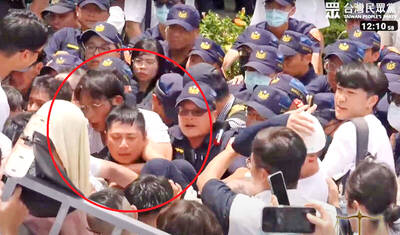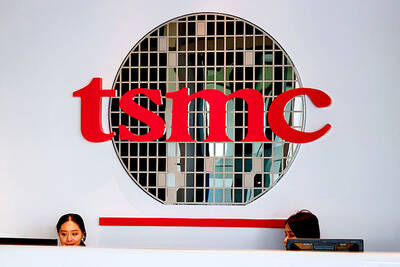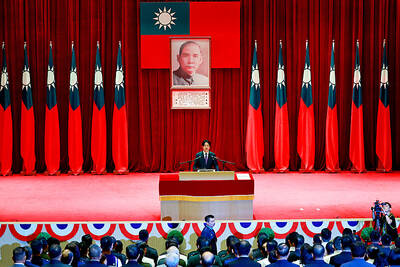Microsoft Corp, the world's biggest software maker, will cut the retail price of its Windows Vista operating system by as much as 48 percent to encourage customers to upgrade and cut piracy in countries such as China.
The cost of upgrading to the Premium and Ultimate editions of Vista will fall between 20 percent and 30 percent in so-called mature markets such as the US, Japan and Europe, Microsoft Corporate Vice President Brad Brooks said in an interview. Full versions will have less of a discount.
Microsoft, which made about 30 percent of its US$51.1 billion in the last fiscal year from Windows, is cutting prices to lure consumers that haven't upgraded from Windows XP, the previous version. Test promotions of the new prices have boosted profit, Brooks said.
LEVER
"It's not so much competition with other companies; they're competing with themselves," said Chris Swenson, an analyst at Port Washington, New York-based NPD Group Inc. "If you're using XP, you may be happy with your computing experience, you may love your computing experience. They really have to work that price lever."
The price cuts are for versions of Vista sold by retailers, which account for a "very small percentage" of Windows revenue, Brooks said.
Approximately 80 percent of revenue in the Windows unit comes from software installed on personal computers. Microsoft spokeswoman Ange McLaughlin wouldn't comment on whether prices will change for computer makers.
"Price is a pretty good lever," Brooks said. "By dropping prices, we're seeing a significant quantity uptake."
Microsoft dropped US$0.33, or 1.2 percent, to US$27.93 in NASDAQ Stock Market trading yesterday. The stock for the Redmond, Washington-based company had fallen 22 percent this year before yesterday.
Prices for full versions of the Basic and Premium editions of Vista will fall 30 percent to 48 percent in emerging markets, Brooks said. The company will eliminate upgrade packages in those countries because they haven't sold well, he said. Price cuts for Vista Ultimate will mirror those in developed markets.
Customers in countries such as India and Russia typically buy full versions of Vista rather than upgrading, Brooks said. That's because they are often seeking to replace pirated software, he said.
About half of Vista sales last year were of the Premium package and upgrade products, which cost about US$173.95 on average, according to Swenson. Ultimate sales made up 24 percent and Basic products accounted for 17 percent. The remaining 9 percent of sales came from Microsoft's Vista Business.
SERVICE PACKThe price cuts will come into effect when Microsoft releases Vista Service Pack 1, a package of fixes to the operating system. That program will be released soon, Brooks said, declining to elaborate.
Distributors for the product such as Amazon.com Inc that have been participating in the trial pricing will have the lower prices sooner, he said.
The suggested price for Windows Basic in the US is US$199.95, according to Microsoft's Web site.
Vista Home Premium costs US$239 and Vista Ultimate is US$399. Retailers such as Amazon.com sell the software for less.
Vista, the first new version of Windows since 2001, was released to corporate consumers in November 2006 and to consumers in January of last year. The product boosted Microsoft's US sales of Windows products by 41 percent last year, according to NPD's Swenson.

TPP RALLY: The clashes occurred near the Chiang Kai-shek Memorial Hall on Saturday at a rally to mark the anniversary of a raid on former TPP chairman Ko Wen-je People who clashed with police at a Taiwan People’s Party (TPP) rally in Taipei on Saturday would be referred to prosecutors for investigation, said the Ministry of the Interior, which oversees the National Police Agency. Taipei police had collected evidence of obstruction of public officials and coercion by “disorderly” demonstrators, as well as contraventions of the Assembly and Parade Act (集會遊行法), the ministry said in a statement on Sunday. It added that amid the “severe pushing and jostling” by some demonstrators, eight police officers were injured, including one who was sent to hospital after losing consciousness, allegedly due to heat stroke. The Taipei

NO LIVERPOOL TRIP: Taiwan’s Lin Yu-ting, who won a gold medal in the boxing at the Paris Olympics, was embroiled in controversy about her gender at that event Taiwanese boxer Lin Yu-ting (林郁婷) will not attend this year’s World Boxing Championships in Liverpool, England, due to a lack of response regarding her sex tests from the organizer, World Boxing. The national boxing association on Monday said that it had submitted all required tests to World Boxing, but had not received a response as of Monday, the departure day for the championships. It said the decision for Lin to skip the championships was made to protect its athletes, ensuring they would not travel to the UK without a guarantee of participation. Lin, who won a gold medal in the women’s 57kg boxing

The US has revoked Taiwan Semiconductor Manufacturing Co’s (TSMC, 台積電) authorization to freely ship essential gear to its main Chinese chipmaking base, potentially curtailing its production capabilities at that older-generation facility. American officials recently informed TSMC of their decision to end the Taiwanese chipmaker’s so-called validated end user (VEU) status for its Nanjing site. The action mirrors steps the US took to revoke VEU designations for China facilities owned by Samsung Electronics Co and SK Hynix Inc. The waivers are set to expire in about four months. “TSMC has received notification from the US Government that our VEU authorization for TSMC Nanjing

CHINESE INCURSIONS, SORTIES: President William Lai thanked military officers for shouldering the responsibility of defending the survival and development of Taiwan President William Lai (賴清德) yesterday said that aggression would inevitably fail, pointing — on the day before a mass military parade in Beijing — to the lessons from World War II and key victories Taiwan claims against Chinese forces in 1958. Taiwan has over the past five years repeatedly complained about heightened Chinese military activity including war games around the nation as Beijing steps up pressure to enforce territorial claims that Taipei rejects. Chinese President Xi Jinping (習近平), flanked by Russian President Vladimir Putin and North Korean leader Kim Jong-un, are to oversee a military parade in Beijing today to mark the